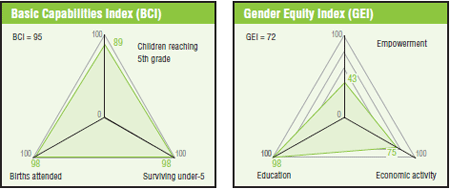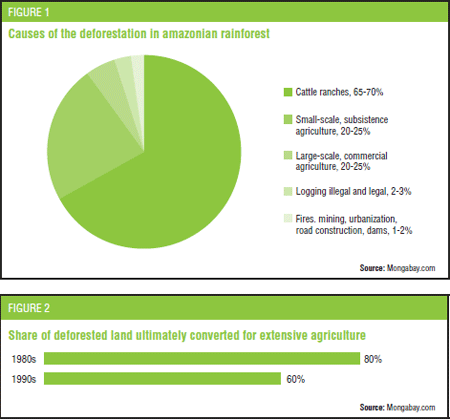The rape of the Amazon
Alessandra Cardoso
Alexandre Ciconello
Institute of Socioeconomic Studies (INESC)
Brazil is a mixture of great prosperity and terrible deprivation. If it is administered in the right way its potential for development is almost unlimited, but the inequalities in society are so vast that it seems they will never be overcome. For the country to achieve sustainable development it will have to tackle many obstacles, and the biggest of these, which affects not just Brazil but the whole world, is the indiscriminate destruction of the Amazon jungle, mainly through logging. This large scale attack, which is being promoted and driven by interest groups of landowners, livestock enterprises and international companies, and facilitated by very poor environmental protection policies and rampant corruption, is well on the way to destroying “the lungs of the world”.
 |
In recent years Brazil has established and expanded a development model in which income and power are increasingly concentrated in the hands of political and economic elites with links to big agro-industrial and financial capital. One of the main foundations of this model is agrarian exploitation, especially the mono-cultivation of crops like soybean and sugar cane (for producing sugar and ethanol), which use genetically modified seeds and agro-toxic products purchased from transnational enterprises. The country is also implementing big infrastructure, energy and mining projects in the Amazon region. Another aspect of this macroeconomic model is high interest rates, and this is a problem for the Government because in the 2000 to 2007 period, for example, amortization and interest payments on the public debt came to around 430,000 million dollars, which was an average of 30% of the State budget per year.
This development model is predatory and unsustainable. Brazil is on the point of making big changes to its environmental protection legislation and it has already relaxed some regulations in the Forest Code.[1] These amendments are geared to protecting the private interests of rural landowners and the big estates, groups that are over-represented in Parliament because the political system is weighted in their favour.
The cornerstone of the Government’s current development policy, which is exactly in line with the strategies of transnational enterprises, is to exploit the Amazon basin and accumulate capital by implementing energy, mining and agro-industrial projects and paying for environmental services. In the period 2000 to 2010, exports from the states that make up Legal Amazonia[2] increased by 518% (from USD 5,000 million to 26,000 million),[3] which is a much higher growth rate than the 366% of the country’s exports as a whole.
In 2010 the state of Pará alone was responsible for 48% (USD 12,8 billion) of the value of exports from this region. In the export pattern, mineral products are by far the biggest item on the list followed by agricultural produce, particularly meat. In the case of Pará, exports by just three enterprises, Vale, Alunorte and Albrás (iron and aluminium) accounted for 78% of the total value sold abroad (USD 10 billion).
The apparent wealth now flowing from the Amazon area is going straight into the pockets of the transnational enterprises’ shareholders, and what is left behind is a legacy of inequality and unsustainability. The production of aluminium alone consumes nearly 6% of the electrical power generated in the whole country. According to the specialist Celio Bermann, “Aluminium is selling at a low price on the international market and it generates few jobs. Seventy times fewer workers are needed for this product than in the food and drink industry, for example, and forty times fewer than in the textile industry.”
The logic of regional integration
Another aspect of this extraction-for-export model is that the Government is allowing Brazilian and international companies to expand their operations in the Amazon basin. This is bringing about accelerating changes in the environment there and in how people live not just in the Brazilian part but in the pan-American Amazon as well. In a series of steps, the Federal Government has increased investment in logistics infrastructure including ports and land and waterborne transport systems. Most of these funds have gone to pay for big construction projects like the huge hydroelectric dams at Jirau, Santo Antônio and Belo Monte (in Brazil) and Inambari, Sumabeni, Paquitzapango and Urubamba (in Peru), and highways like the controversial Villa Tunari-San Ignacio de Moxos in Bolivia, which cuts right through indigenous peoples’ lands in the Isiboro Sécure National Park. These large scale works were carried out by Brazilian firms and financed with public money from the country’s National Economic and Social Development Bank.
The Government is also providing more tax and credit incentives to attract the private sector to the region, in particular with projects to generate and distribute electrical energy. This has opened up the Brazilian Amazon even more to public and private enterprise involving international as well as domestic firms, which is making this predatory model of natural resource exploitation even stronger.
Climate change and agriculture
Deforestation in the Amazon and the rearing of livestock are the two main causes of CO2 and CH4 gas emissions in Brazil (67% and 70% of total emissions, respectively).[4] There is a strong connection between logging (and burning off vegetation) and the fact that land in the area is concentrated in very few hands, and this is clearly connected to the dynamics of the expansion of agricultural land. This concentration of land ownership increases the risk that the country’s climate change policies will mainly benefit the big landowners because it is they that will receive the various kinds of subsidies, and rural communities and the indigenous population will find themselves more excluded than ever.
 |
However, the Government has not taken any effective action that goes to the heart of the problem. What is needed is agrarian reform whereby a new model for the use of land and its resources can be implanted in the Amazon, based on the sustainable use of natural resources and respect for the traditional communities’ and indigenous people’s different ways of life. Bear in mind that these people have been living in harmony with their jungle environment for many centuries.
In a recent Social Watch study[5] a Basic Capabilities Index rating was calculated for the various states and municipalities in the Amazon taken separately, like the analysis for the country as a whole. This report confirmed that there is a vast gulf between the prosperous regions of Brazil and the poor ones, and the poorest of all are in the north of the country. At the bottom of the list for satisfying the population’s basic necessities we find the states of Pará, Acre and Amazonas. When we consider each indicator in isolation it emerges that inequality between the different regions is even worse in the sphere of education and Pará is in the worst situation of all.
Changes in the legal framework
There have been many attempts to make the prevailing legislation about the environment more flexible. The outstanding example of this campaign to relax environmental controls was when the Forest Code was weakened as a result of pressure from powerful interest groups representing the agriculture sector, whose overall strategy is to expand the agricultural frontier further and further into the Amazon. Rural landowners are pressing for a range of measures and one of these, which is contained in a bill currently before the Chamber of Deputies (the lower house in Parliament) is to reduce from 80% to 50% the proportion of land that all rural holdings in the Amazon must maintain as native forest.
The Government regards the Rio Madeira hydroelectric complex as a crucial component in its plans to meet the country’s energy needs as of 2010 - 2012, and it considers the generation and transmission of electric power as the cutting edge of the “advance of the electric frontier”. But in fact the increase of 6,600 MW of installed power (3,150 MW in Santo Antônio and 3,450 MW in Jirau) will be used to satisfy a demand the Government and the electric energy sector have themselves created artificially. The power generated at the Madeira complex will be supplied to the economic centre of the country, which is the south west, and a lot of investment will be required to build the 2,375 km of power lines and stations needed.
It has been estimated that USD 21 billion[6] will have to be invested in the group of projects connected to the Madeira complex, but up to now only USD 9,3 billion[7] has been approved. Of this total some 8,6 billion is from the BNDES, including direct and indirect operations, and another 700 million is from the Amazon Bank (BASA) using public finance from the Constitutional Fund of the North and the Amazon Development Fund.
Data from investment reports on the Amazon show that, because of the risks involved in the project, the construction work and the process of obtaining environmental authorisation, there is strong pressure from the public as well as the private sector (which includes banks, public bodies, companies, lobbyists, managers and agents) that nothing should be allowed to interfere with the timetable of the projected works, and nothing should delay the start. It is being argued that the economic feasibility of the Madeira complex depends on the hydroelectric system going into operation as soon as possible, and therefore the process to obtain authorisation is being rushed through without due consideration of the social and environmental impacts the mega-project will have in the area.
Workers on these projects are being exploited (the Ministry of Labour has detected more than 2,000 infractions), the murder rate in the area has gone up by 44%, the sexual exploitation of childs and adolescents increased 18% in the period 2008 to 2010, and the number of rapes went up by 208% in 2007 to 2010. These are the effects of the development model financed by public funds, and Brazil is exporting this same model to other South American countries and to African nations like Angola and Mozambique. It is a model that serves the elite but destroys the environment and violates human rights on a large scale.
[2] The administrative area in Brazil made up of nine states in the Amazon basin.
[3] Source: Ministry of Industry and Trade. Nominal values, in dollars.
[4] Ecoportal.net. “Cultivando el desastre. Agricultura, ganadería intensiva y cambio climático”. <www.ecoportal.net>.
[5] Social Watch, “Basic Capabilities Index – BCI Brazil”. 2009.
[6] Bank Information Center “The Madeira River Hydroelectric Complex” <www.bicusa.org/es/Project.Financing.10138.aspx>.
[7] See: <wnotes.furnas.com.br>.


